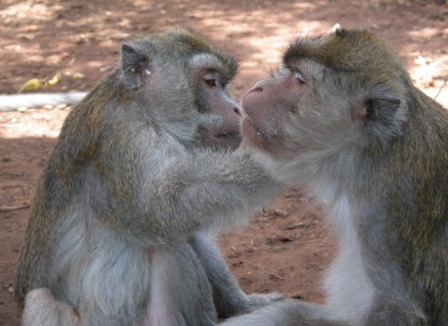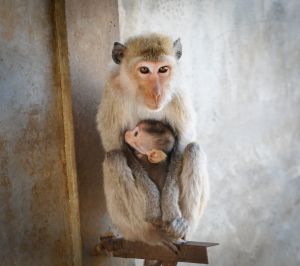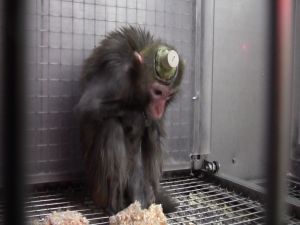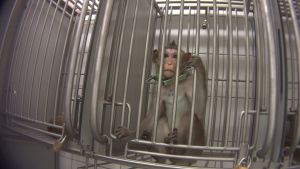Action for Primates

|
Action for Primates |

|
|
Tens of thousands of non-human primates are used across the world in research and testing every year. In the USA, 70,797 non-human primates were used in 2018 and an additional 35,221 were held in research facilities, but not used (USDA 2020). In the European Union (EU), 11,609 procedures were carried out on non-human primates in 2017, with France (3,746), Germany (3,472) and the UK (2,960) being the main users (EC 2020). Other countries that use great numbers of non-human primates in research include Canada, Japan and China (which is also a major exporter of non-human primates for research and testing). Old World non-human primate species commonly used in research are rhesus macaques (Macaca mulatta), long-tailed macaques (Macaca fascicularis), baboons (Papio spp) and grivet monkeys (Chlorocebus aethiops). New World monkeys used include squirrel monkeys (Saimiri sciureus), owl monkeys (Aotus spp), common marmosets (Callithrix jacchus), and tamarins (Saguinus spp).

The long-tailed macaque is the most heavily traded and most widely used non-human primate species. They are mainly exported from large breeding facilities in Cambodia, China, Laos, Mauritius and Vietnam. In some countries, standards at such facilities are often inadequate to meet the psychological and behavioural needs of the animals, and there are concerns regarding the status of some of the captive breeding colonies (CFI 2015). In Europe and the US, there are also several domestic breeding colonies that supply non-human primates to laboratories.
Some non-human primates used in research are trapped in their native habitat (wild-caught) or are the offspring of at least one parent who was trapped in the wild. Capturing free-living monkeys is cruel and inflicts substantial suffering and distress, as the animals are forcibly removed from their habitat and family and social group. Non-human primates are highly social animals whose sense of well-being and whose welfare are strongly and inextricably dependent on intact family and similar social structure (Novak et al 2013). Removal of individuals from the social group results in fractured families and social bonds. This causes extreme stress and distress for those taken as well as those left behind, the effects of which last indefinitely (Lopresti-Goodman et al 2013).
There are also the issues of holding and transportation, which are additional sources of stress and suffering. The monkeys are shipped on long journeys around the world in the cargo holds of airplanes. There has been much evidence accumulated over the years that has revealed the immense cruelty and suffering that is inflicted on monkeys during their capture, caging, holding and transportation (BUAV 2008, 2009, 2009).
Studies carried out by scientists from within the research industry itself have shown that transportation causes profound negative effects on the behaviour and welfare of long-tailed macaques and other non-human primates (Fernström et al 2008; Honess et al 2004; Schapiro et al 2012). The animals are often packed into small wooden crates for shipment. The crates are too small to permit any exercise nor even normal postural adjustments. Transportation to the destination, including transfers, air and ground transit times, can take days to complete. During this time, the monkeys may have to endure delays, inadequate ventilation, noise and extreme temperature fluctuations.
Non-human primates are subjected to experiments and procedures that can cause immense suffering, discomfort and substantial pain. They are almost always killed at the end of the experiments.

Regulatory toxicological tests are the area in which most non-human primates are used, and the long-tailed macaque is the primary species. Toxicity (causing damage to the individual or poisoning) testing is carried out to assess adverse reactions to drugs (or chemicals), primarily for the purpose of developing commercial products for humans. This usually involves restraining the monkeys to give different doses of the test drug. The drugs are usually given intravenously (directly into the bloodstream) or injected through a tube that is forced into their mouths to reach the stomach. As part of the restraint, the monkeys may be pinned by their necks in a device euphemistically called a 'primate chair' by the research industry. The nature of the drug dictates the rate at which the animals are dosed and this is often daily. Depending on the drug administered, the animals may suffer visible effects such as lethargy, vomiting, seizures, difficulty breathing, skin problems and weight loss. Invisible effects may include internal bleeding and organ failure. With some drugs, even at low doses, there may be outright death.
Scientific validity of animal toxicity tests: Different species react differently to a drug or chemical and toxicity testing cannot predict the adverse effects that humans will experience. There will always be difficulties with extrapolating from one species to another, and from carefully controlled laboratory experiments to the human condition and actual human life situations.
A new review looking at whether drug tests on animals help predict human responses concluded that after decades of animal use in human drug development, there is little evidence to support using animals in drug tests, or to suggest that animals can effectively predict how people will react to drugs (Bailey & Balls 2019). One such analysis of toxicity testing data showed that test results inferring an absence of toxicity in one species provide no evidential reliability with regard to toxicity in any other species, even when monkeys are used to compare with human beings (Bailey et al 2015).
Sometimes the failure of drug safety testing to accurately predict what will happen in a human being can be fatal, such as the Northwick Park Hospital disaster in the UK in 2006 (Dowsing & Kendall 2007). In this case, six human volunteers nearly died testing a drug that had shown no adverse effects in non-human primates at 500 times the dose. Another study has shown that long-tailed macaques are resistant to doses of paracetamol that would be fatal in human beings (Yu et al 2015).
There is evidence that the results of testing on animals may not always be used to dictate clinical applications. For example, babies were given a trial vaccine that did not work in monkeys (Newell & Malnick 2017).

The following are examples of just some of the areas of research in which non-human primates are used.
Neurological: Deliberate damage to the brains of monkeys is done by various means in order to study the effects on cell function and behaviour. This may be done with poisons such as MPTP (Ma et al 2012) or by drilling through the skull into the brain and physically mutilating specific sites (O'Reilly et al 2013). Electrodes are often surgically implanted in the brain using a device screwed into the skulls (Goonawardena et al 2016). Either before or after surgery, the animals may be deprived of food or water (fluids) in order to coerce (euphemistically called 'training' by the research industry) them to do certain tasks (Varazzani et al 2015), to see what effects the brain damage has on them. In order to do this, the animals are restrained in 'primate chairs', sometimes so severely to the point where they can only move their eyes or the hand that is being used for the task.
Infectious diseases: Although non-human primates are being used extensively in research on diseases such as human acquired immune deficiency syndrome (AIDS), they are not naturally susceptible to nor infected by the organisms involved (such as the human immunodeficiency virus [HIV]). Even when artificially injected with HIV, they do not develop AIDS or not in a way that is similar to the disease in people. Although monkeys such as macaques can naturally develop a similar disease (simian acquired immunodeficiency syndrome [SAIDS]) when infected with the simian immunodeficiency virus (SIV), the diseases are dissimilar enough that the information derived cannot be reliably applied to people. When artificially infected with SIV in the laboratory, the animals suffer immensely through extensive weight loss, major organ failure, breathing problems, diarrhoea, vomiting, loss of appetite and neurological disorders.
Other diseases: Because non-human primates do not develop many of the diseases, such as Alzheimer's, seen in people, they must be manipulated either surgically or chemically in order to cause damage that results in abnormalities that look like, but are not really, similar human diseases. For example, non-human primates do not develop Parkinson's disease, so researchers attempt to simulate the human disease in the animals by injecting them with a neurotoxin called MPTP (Ma et al 2012). This toxin (poison) does not cause Parkinson's disease, even in human beings (Snow et al 2000), rather it destroys dopamine producing cells, thereby inducing signs that bear only a superficial resemblance to human Parkinson's disease. The non-human primates become disabled, cannot move properly, cannot adequately feed and water themselves. They have to be hand-fed otherwise they would starve to death.
Addiction: Non-human primates are forced to become addicted to recreational drugs such as alcohol and cocaine. They often have a tube surgically implanted into their veins so that they can administer the drug directly to themselves. Addiction is much more than a physical disease in people and forcing monkeys to become addicts is not only extremely cruel, it does not provide the answers needed to help people suffering from addiction.
Maternal deprivation: Despite the fact that the effects of depriving human children of maternal care are well known, non-human primates continue to be subjected to this cruelty (King 2015; Law et al 2009; Shrestha et al 2014; Simpson et al 2017; Wang et al 2018). Besides being unreliable indicators of the human experience – one which is far more complex than can be replicated experimentally – depriving newborn or infant non-human primates of the strongest bond they have – with their mothers – is particularly cruel. There can be no debate that depriving an individual of maternal care, in non-human primates, human beings and others, causes major and lasting negative effects. Given that there are countless human children who have been – and will continue to be – deprived of maternal care or related issues, there is no justification for continuing to cause this artificially in non-human primates. We should be putting all our efforts, resources and intellect into studying these unfortunate children in an effort to help them, rather than creating more misery.

Non-human primates are wild animals and retain their 'wildness' even if bred in captivity. They do not adjust well to a captive environment. They are intelligent animals with complex behavioural, psychological and social needs. Such needs can never be met in the unnatural and artificial environment of a laboratory. The animals are often housed on their own in barren steel cages that do not allow them to satisfy their natural behaviours and provide no meaningful environmental enrichment. Maladaptation due to lack of mental stimulation, socialisation with others of their kind (including especially their extended family) and physical exercise results in repetitive abnormal and self-destructive behaviours (known as stereotypies) that may include pacing, rocking, swaying, and self-mutilation.
Although these cages may be within 'legal limits', they certainly are not conducive to the psychological and physical well-being of the individuals. This type of housing constitutes extreme privation and cruelty for the animals.
This privation is not only detrimental to the individuals in the cages, it also can have tremendous confounding effects on data which come from the monkeys (Petticrew & Smith 2012; Sapolsky 1993). There are numerous scientific publications showing how factors such as environment and socialisation have a profound effect on the results of a particular experiment on various species, including non-human primates (Bailey 2018; Kraemer et al 1984; Niehoff et al 2010). This means that the results of studies on monkeys would have to be viewed with suspicion and scepticism with respect to their scientific credibility and reliability (Petticrew & Smith 2012).
There are strong moral and scientific arguments against the use of non-human primates in research.
Morality: It is often stated that the similarities to human primates makes the use of non-human primates indispensable in medical research to help human beings. It is, however, precisely these similarities that make their suffering and use so unjustifiable. They are not simply machines that exhibit and have functions similar to people. They also carry with them the underlying abilities to feel pain; to suffer; to experience anxiety, fear and depression; to show signs of experiencing joy or enjoyment; to provide human-like care for others of their own kind; these traits are morally relevant and should be part of our decision-making process on whether to experiment upon non-human primates. In short, if we find it morally unacceptable, and rightly so, to do certain things to human beings despite the potential for enormous benefits, then we should find it equally unacceptable, by our own standards of morality, to do these things to other primates.
Science: Despite the general biological similarities between non-human and human primates, this does not mean that the effect of a drug or chemical will be the same in both species. Nor does it mean that diseases, especially those that are unnatural and must be artificially created, in non-human primates mirror those in people. As already explained earlier, diseases such as AIDS or Parkinson's do not occur in these animals.
Of great importance is the fact that the entire situation surrounding non-human primates in captivity is artificial; the animals are not 'normal' in the usual sense of the term. The stress or distress they experience has profound effects on their immune systems and physiologic responses. Data derived from experiments or testing drugs on them, therefore, are likely to be unreliable with respect to applicability to people. Other issues that occur only in human society – such as socioeconomic or psychological issues – have a major impact on human illness, further compromising the usefulness and safety of non-human primate data.
There are numerous alternatives to using non-human primates in research and toxicity testing (Taylor 2019). These alternatives have been shown to provide reliable and predictive information for the human condition, and include human cell, tissue and organ cultures; microdosing; computer models; safe and morally defensible studies on human volunteers, including patients, using very elegant and sophisticated techniques (Sims-Williams et al 2016, 2017).
If we want to learn about human function and disease, then we need to place greater emphasis on the study of human beings using nature's "experiments" as our laboratory, rather than attempting to depend on the vagaries inherent in non-human animal research, even with species similar to us like non-human primates. For example, to determine the connections of the retina to various parts of the brain – something meaningless to do in non-human primates due to structural differences – one could study a person who has had an eye removed at some point in their life. Sophisticated electrophysiological and biochemical studies can be conducted throughout the person's lifetime. Postmortem studies of the brain can compare the anatomy and biochemistry with that of a person who had not lost an eye. The same principle can be applied to any situation (Cowey & Alexander 2012; Gilbert et al 2012; Palca 1990; Weiskrantz et al 1974; Willoughby 2012).
The present level of sophistication for human studies necessary to understand the human condition is considerable (Larsson et al 2010; Lawwill 1978; Sallet et al 2013). For example, human volunteers and positron emission tomography were used to demonstrate a regional reduction in cerebral glucose metabolism in patients with optic neuropathy (Kiyosawa et al 1989). Similar technology was used to study glucose metabolism in the brain of patients with depression (Baxter et al 1989). In other studies, patients with refractory seizure disorders and who were undergoing evaluation for therapeutic brain surgery were studied to get information on human brain structure and function (Uematsu et al 1992). These patients had subdural electrode grids implanted. Cortical mapping was done by electrical stimulation of the cerebral cortex in order to learn important neuroanatomical details of the human motor cortex, information virtually impossible to derive from non-human primates or any other animal.
Positron emission tomography and magnetic resonance imaging have been used to measure activity-related changes in regional cerebral blood flow to identify brain regions which are active in human beings during reading or playing the piano (Petersen et al 1988; Posner et al 1988; Sergent et al 1992). Human visual field representation in the occipital cortex has also been achieved (Wong & Sharpe 1999). This combination of cognitive and neurobiological approaches has provided information about the functional anatomy of perception, attention, motor control, and language in the human being, again, something not likely to be possible with non-human subjects of any kind, including non-human primates.
Other techniques that can be used on human beings include transcranial magnetic stimulation to study the functionality of the circuitry and connectivity of the brain (Koch et al 2009), diffusion tensor imaging for evaluation of nerve dysfunction (Sugiyama et al 2009), magnetoencephalography to study intricate brain function (Vartiainen et al 2009) or single photon emission computed tomography to evaluate treatment effects (Akar et al 2009). These are just a few of the numerous techniques that are available for getting useful information from and for human beings.
These types of studies provide us with information about human structure, function and pathologic conditions which will be invaluable in understanding and treating human disorders. They also demonstrate that claims that non-human primates for this sort of work are absolutely necessary are simply not true. There is little question that similar approaches could be taken to do any kind of human research including those currently being pursued such as Alzheimer's disease, Parkinson's disease or AIDS research.
In summary, using non-human primates such as monkeys in research designed to benefit human beings is not only immoral, it is also scientifically unnecessary and potentially dangerous to people. Human beings are an intelligent and capable species. If we use our intelligence compassionately, we can find ways to answer the questions we want without having to harm and kill non-human primates or others.
See elsewhere for more examples of using human beings to get human-relevant data.
Research: new hypotheses or questions are asked and experiments are designed or carried out to address these.
Testing: determining whether a particular product/drug/vaccine and so forth is either effective or is not toxic.
The 'primate chair' is a crude device used to severely restrain non-human primates. The animals are often immobilised by their necks, with their legs further restrained either with straps or tape. Depending on what is being done to the individual, the head may be held in place with a clamp or through the use of surgically implanted bolts into the skull.
The transport boxes used for single caged monkeys were standard transport boxes...
This study demonstrates that, as a whole, the process of international air transport and re-housing in laboratory conditions may result in the compromising of the welfare of the study animals.
Ingenious investigators have discovered a great deal about amblyopia in the intact human being by using psychophysical and electrophysiologic techniques. ... By supplying unique stimuli separated in time or space to the visual field of one or both eyes, it is possible to determine which neural interactions in visual processing occur at different levels of the visual system, from the retina to the cortex, and to discover which specific steps in processing are abnormal in amblyopia.
Our results highlight some lesser known harms of the bushmeat trade and the detrimental life-long consequences that keeping chimpanzees as "pets" can have on their mental health.
In the monkey study, five out of six of the animals infected with TB who were given the experimental vaccine had become "very unwell" and had to be put down. An information sheet given to families in South Africa participating in the trial said the vaccine had been tested on animals and humans and was "safe and effective" in animals.
We have used recent advances in the precision of positron emission tomography (PET) for measuring activity-related changes in regional cerebral blood flow to identify brain regions active during three levels of single-word processing.
The combination of cognitive and neurobiological approaches, of which this study is an example, has given us information about the functional anatomy of perception, attention, motor control, and language. As these endeavours proceed, solutions to the problem of mind-brain interaction that have intrigued us for so long should be illuminated.
The use of positron emission tomography to measure regional changes in average blood flow during processing of individual auditory and visual words provides support for multiple, parallel routes between localized sensory-specific, phonological, articulatory and semantic-coding areas.
[N]ew data from neural imaging studies of word reading are related to results of studies on normal subjects and patients with lesions. Further support [for a particular cognitive theory] comes from studies in mental imagery, timing, and memory.
With the use of positron emission tomography and magnetic resonance imaging, the functional neuroanatomy of musical sight-reading and keyboard performance was studied in ten professional pianists. ... These findings help explain why brain damage in musicians may or may not affect both verbal and musical functions depending on the size and location of the damaged area.
Readers should note that many findings from behavioral and biochemical studies in monkeys and other animals are not replicated in humans. Accordingly, this study cannot directly address the safety or efficacy of SSRIs [selective serotonin reuptake inhibitors] in children and adolescents with psychiatric disorders. ...this animal model of maternal separation has never been validated as a measure of drug efficacy in humans. ... The only way to know definitively whether SSRIs persistently upregulate SERT in humans would be to study our species.
The studies were performed on 35 patients with refractory seizure disorders who were undergoing evaluation for ablative brain surgery.
...we examined in detail the records of cortical mapping done by electrical stimulation of the cerebral cortex via implanted subdural electrode grids in 35 patients with seizure disorders. ... Our study reconfirmed that a significant number - at least one-third - of motor responses are distributed outside the classic narrow cortical strip. In patients with brain lesions, the motor representation is further displaced outside the narrow strip. This finding indicates that primary motor cortex may extend beyond the gyrus immediately anterior to the [Rolandic fissure].
Careful, respectful genetic study of these genetically unique populations may provide information on which pathways in human biochemistry and physiology promote resistance to human rabies.
![]()
![]()
![]()
![]()
![]()
Contact us via E-mail
Copyright © 2020-2025 Action for Primates. All rights reserved.